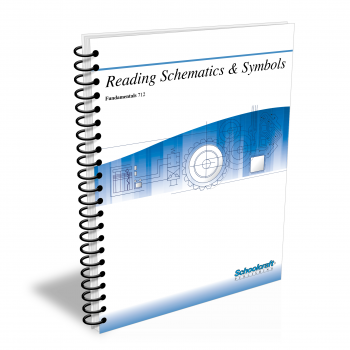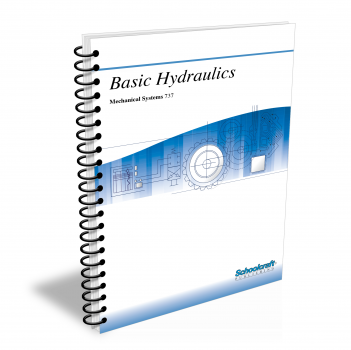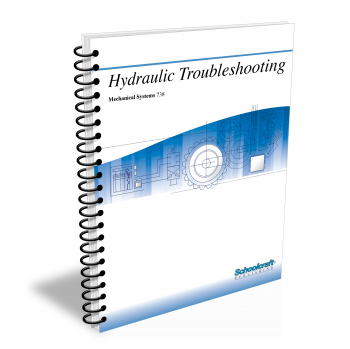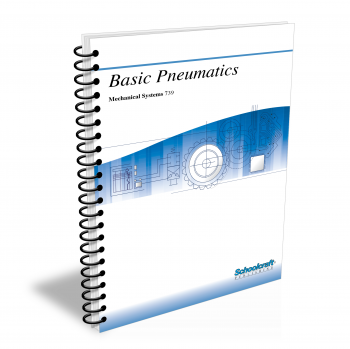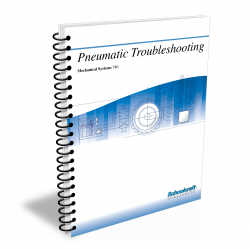Pneumatic and Hydraulic Maintenance
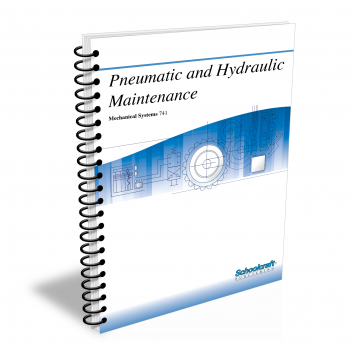
Course Number: 741
The first half of the Pneumatic and Hydraulic Maintenance textbook focuses on pneumatics. It begins with pressure, force, work, and energy as well as system components. This textbook continues with an overview of pneumatic diagrams, system components, maintenance, and troubleshooting. The second half of the textbook deals with hydraulics focusing on the system as a whole. It concentrates on valves, cylinders, maintaining hydraulic systems, and troubleshooting.
Does your curriculum require additional topics not included in this textbook? Build a customized version of the Pneumatic and Hydraulic Maintenance textbook below.
Recommended Contact Hours – 23
Preview a Chapter
Available Supporting Material
- Table of Contents
- Exam Copies
- Suggested Titles
Table of Contents
Chapter 1: Principles of Pneumatics
Topics: Fluid power systems; Force, weight, and mass; Pressure; Work and energy; Diffusion and dispersion; Compressibility; Laws of pneumatics; Leverage; Air properties and flow; Bernoulli's Law; Components
Learning Objectives:
- Explain how force is transmitted in a pneumatic system.
- Calculate force and work.
- List two factors that affect the results of pressure calculations.
- Explain pneumatic leverage.
- Briefly explain the physical laws affecting the behavior of a confined gas.
Chapter 2: Directional Control Valves
Topics: Manually and automatically operated valves; Control valve elements: spools, poppets, disks, and plates; Two-, three-, four-, and five-way valves; Accessories
Learning Objectives:
- Describe the four methods of identifying control valves.
- List four basic types of manually operated, two-way
- Describe the operation of a two-position, direct acting,
- Explain one major advantage of using a four-way
- Describe the construction of a three-way valve.
Chapter 3: Pressure Control Valves
Topics: Safety vs relief valves; Relief valve construction; Pressure regulators; Pilot-operated, remote-controlled regulators; Logic functions
Learning Objectives:
- List two ways a valve can control compressor pressure output.
- Describe construction of two basic types of pressure-relief valves.
- Contrast a pressure regulator with a pressure-relief valve.
- State the limit imposed by Federal Law on the pressure allowed when an air hose is used to blow off chips.
Chapter 4: Pneumatic Cylinders
Topics: Double-, single-acting cylinders; Two-piston cylinders; Cylinder construction, mounting, and selection; Performance charts; Cushioning
Learning Objectives:
- Tell the difference between pneumatic and hydraulic cylinders.
- Describe the construction and operation of a single-acting cylinder.
- State the purpose of an exhaust flow control metering valve.
- Describe the action of a pivoted cylinder.
- Explain the size relationship between a cylinder port and a valve port.
Chapter 5: Pneumatic Systems
Topics: Air supply system; Reciprocating and rotary compressors; Cooling; Compressor maintenance; Air-line filters and lubrication
Learning Objectives:
- Explain the operation of linear actuators-cylinders-in a typical pneumatic circuit.
- Describe the various types of compressors and how they work.
- Define intercooling and aftercooling.
- Describe basic preventive maintenance procedures for compressors.
- List the components of an effective delivered-air system and explain how they work together.
- Describe the three main types of air-line lubrication.
Chapter 6: Installing Pneumatic Components
Topics: Compressor intakes and foundations; Aftercoolers; Receivers; Dryers; Pipe installation and support; Tubing and hose fittings; System installation
Learning Objectives:
- Describe the proper installation of the compressor and its auxiliaries.
- Describe the installation of aftercoolers, receivers, and dryers.
- Explain the correct procedures for installing pipes, tubes, and hoses in pneumaticsystems.
- Describe the installation of control valves, solenoid coils, and cylinders.
Chapter 7: System Maintenance
Topics: Control system maintenance; Cylinder maintenance; Tool maintenance; Logs and records; Automatic recorders and recording charts
Learning Objectives:
- Explain the concept of planned maintenance.
- Describe the basic procedures for maintaining the compressor and other important components in a pneumatic system.
- Describe the maintenance of industrial control circuit components.
- Explain the proper maintenance of pneumatic tools.
- Discuss the various types of maintenance logs and explain what kind of information is recorded in each.
Chapter 8: System Troubleshooting
Topics: Locating troubles; Operations manual; Checking the air supply; Troubleshooting valves and actuators; Interlocks; Final adjustments
Learning Objectives:
- List, in proper sequence, the steps to be taken in troubleshooting a pneumatic system.
- Name and describe the five important parts of every pneumatic system's operations manual.
- Describe procedures for troubleshooting the actuator.
- Explain how to check control valves, sequence valves, and interlocks.
Chapter 9: Directional Control Valves
Topics: Valve classification; Automatic, two-way, check, pilot-operated, and spool valves; Hydraulic motors; NO, NC, holding valves; Symbols; Flow ratings
Learning Objectives:
- Explain the classification of directional control valves.
- Describe how manually operated valves work.
- Explain the difference between direct-acting and pilot-operated valves.
- Describe the operation of a check valve, a spool valve, a three-way valve, a four-way valve, and a rotary valve.
- Explain the difference between normally closed and normally open valves.
Chapter 10: Pressure Control Valves
Topics: Poppet, spool, sequence, counterbalance, holding, unloading, and pressure-reducing valves; Shock suppressors; Flow-control valves
Learning Objectives:
- Explain the functions of a pressure-control valve, a pressure-relief valve, and a pressurereducing valve.
- Describe the operation of a spool valve, a poppet valve, and a sequence valve.
- Explain the purpose of holding valves, unloading valves, and counterbalance valves.
- Name the operations performed by flow-control valves.
- Describe how pressure compensation and temperature compensation work.
Chapter 11: Hydraulic Cylinders
Topics: Double-, single-acting cylinders; Two-piston cylinders; Positional cylinders; Cylinder construction; Rings, seals, and packing; Cylinder mounting and selection; Flow capacity; Cushioning
Learning Objectives:
- Describe the purpose of a hydraulic cylinder, and explain how a double-acting cylinder works.
- Explain the difference between "pull-type" and "push-type" single-acting cylinders.
- Describe the construction of a hydraulic cylinder.
- Explain the various methods of mounting cylinders.
- Demonstrate how to calculate the flow capacity of a hydraulic cylinder.
Chapter 12: Maintaining Hydraulic Systems
Topics: Inspections; Maintenance requirements; Fluid level; External leaks; Operating pressure; Fluid quality; Filter maintenance; Reconditioning
Learning Objectives:
- List the major categories of hydraulic system maintenance.
- Name and describe the six essential items in a maintenance file.
- List the steps involved in reconditioning a hydraulic component.
- Explain how to set up a maintenance plan for a typical hydraulic system.
Chapter 13: System Troubleshooting
Topics: Diagnosis and symptoms; Evaluating machine history; Determining the cause; Providing the solution; Tools and gauges; Troubleshooting charts
Learning Objectives:
- Describe the troubleshooting process.
- Explain how to evaluate recent maintenance history.
- List typical symptoms of common hydraulic system problems.
- Explain how to determine the cause of and provide a solution to a problem.
- Explain how a portable tester works.
- Describe how to keep and use troubleshooting charts.
Chapter 14: Valve Troubleshooting
Topics: Valve problems and test procedures; Disassembly, cleaning, and inspection; Repair and replacement; Solenoid problems; Reassembly and testing
Learning Objectives:
- Name five common valve problems and explain the sequence of steps to be followed in troubleshooting them.
- Describe the proper procedures for valve disassembly, cleaning, and inspection.
- Explain how to determine whether to repair or replace a malfunctioning valve.
- Describe the reasons for hydraulic "wire drawing."
- List the reasons for electrical and mechanical failures of solenoid valves.
- Explain the procedures for reassembling, reinstalling, and testing valves.
Chapter 15: Cylinder Troubleshooting
Topics: Cylinder descriptions; Troubleshooting procedures; Cylinder testing, repair, and installation; Shock absorbers
Learning Objectives:
- Name the most common types of hydraulic cylinders and identify their major parts.
- List the symptoms of internal and external cylinder misalignment.
- Explain what to do if you find internal leakage in a cylinder.
- Name the cylinder components most frequently replaced.
- Explain the purpose of a piston rod boot.
- Describe the symptoms of shock absorber failure.
Request Exam Copies
Exam Copies
Ready to see a copy of our textbooks? After selecting which textbooks you’d like to review for your course, you can submit your request by either logging in or creating an account so we know where to ship your exam copies. A representative from Schoolcraft will contact you to confirm and finish processing your request.
Exam copies are always free and yours to keep.
Selected Exam Copies
none selected
* Maximum of five copies can be ordered
